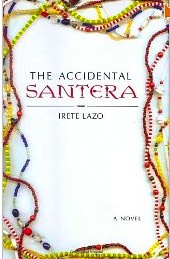By Iya Sauda Smith
 There is a Yoruba Proverb which states: “No matter how far the stream flows it never forgets its source.” This seems to be the basic premise of the latest offering in Latino/Santeria fiction by Irete Lazo. While this might be written as a woman’s journey to the sacred priesthood of “Ocha,” the underlying message is one of birthright and the preservation of culture. The author takes the reader on a pleasant journey as we bear witness to growing faith and a spiritual epiphany.
There is a Yoruba Proverb which states: “No matter how far the stream flows it never forgets its source.” This seems to be the basic premise of the latest offering in Latino/Santeria fiction by Irete Lazo. While this might be written as a woman’s journey to the sacred priesthood of “Ocha,” the underlying message is one of birthright and the preservation of culture. The author takes the reader on a pleasant journey as we bear witness to growing faith and a spiritual epiphany.
The protagonist of the novel is a middle class academic who comes from humble beginnings. We find her navigating the throes of academia and a marriage that has become lukewarm with the pressures of work and an inability to produce children. Through a series of “coincidences” and intellectual curiosities, Dr. Segovia runs straight into her heritage. The story then winds its way through Dr. Segovia’s various sacrifices and ceremonies until it culminates in the inevitable: her initiation as a priestess.
What differentiates this offering from prior anthropologically slanted fiction on the Santeria religion is that Lazo is able to make the reader identify with Segovia. The novel flows logically and comfortably. She has removed the “spooky” elements that are so prevalent in other fiction regarding Santeria. With Lazo’s tale, you are ready to curl up and read about someone who could be one of your own acquaintances. She has given the novel an appropriate contemporary feel that addresses the modern day believer. The audience feels Segovia’s conflict in accepting that divination is not based on lucky guesses and broad generalizations. The audience can trust the fact that her work as a scholar, particularly as a scientist does not predispose her to the faith necessary to be obedient and complete tasks that do not seem sensible. Ultimately, any contemporary practitioner will shake their heads at some of the precarious situations that Segovia finds herself in at work, amongst friends and at home amidst unbelievers.
Lazo has created a believable character Benito, Segovia’s husband who, although raised in close contact with the religion, maintains no belief in Santeria. His development through the novel will make you want to choke him as well as stand up and cheer.
The one element of the novel which some might find objectionable is the openness regarding that which is considered sacredly secret. One might ask: “why do we need to know all of the intricacies involved in the ceremonies to consecrate priests? After all who knows but the cardinals, how the Pope is made Pope?” Lazo seems to have no hesitation revealing some of the most sensitive information in order to make Santeria appear “normal.”
She carefully touches on her perceived difference between Santeria and what those “African” oriented people do in their worship. Perhaps, some dialogue will commence after reading the book regarding this fascinating yet potentially volatile issue.
Lazo has provided some stimulating weekend reading for practitioners and non-believers alike. In my opinion this novel can be viewed as truly representative of what a twenty-first century Latino professional might experience in their initial introduction to Santeria, and their ultimate conversion.
Iya Sauda Smith is a priestess of Obatala, holds an Master from the University of Wisconsin, Madison in African Languages and Literatures and is currently writing her dissertation.



